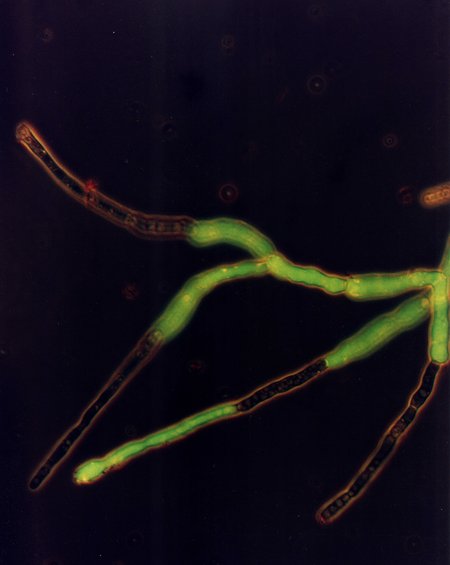Research Overview
We are interested in fungi and bacteria. Most important for us is their metabolism.
Our scientific questions are:
Can we isolate an interesting microorganism from the environment?
Which catabolic or anabolic processes can be observed?
Which enzymes are involved?
How does their regulation work?
How can we increase the rate of a wished reaction?
Can we avoid the formation of unwished products?
Metabolism of fungi
i.e. overproduction of vitamin B2 by Ashbya gossypii
The wild type of the fungus A. gossyii can produce up to 100 mg vitamin B2 per g biomass. This is 10% of its hyphal mass with several thousand compounds.
Our scientific question is:
What triggers overproduction?
Production of enzymes
i.e. isolation, immobilisation, characterisation and assay of microbial lipases
We screen for microorganisms that can grow under selective conditions, e.g. on mineral salt medium at pH 3 with plant triglycerides as sole source of carbon and energy. An interesting example is the mold Phialemonium curvatum. It produces a cell wall associated lipase. Such enzymes are interesting for industrial applications. Since they work on lipid water interfaces it is a challenge to quantify their hydrolytic activity. Therefore we develop assay systems.
Bioleaching
i.e. investigation of the bacterial role in acid mine drainage
Senftenberg is located in an area with a history of lignite mining. Since more than a century coal is removed, nowadays mainly to produce electrical current. The overburden contains about 1% iron sulfide causing acid mine drainage under aerobic conditions. We isolated more than 100 microbial strains showing iron and sulfur oxidising properties. An example isAcidithiobacillus ferrooxidans converting Fe(II) to Fe(III).
Model development
We use our results to develop models that explain phenomena.
We try to support our conclusions by quantitative data.
We are happy if our results contribute to economically relevant problems.


